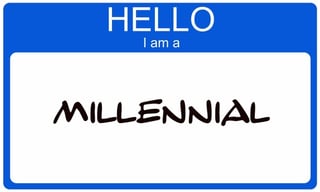June 2, 2016 | Mike Pumphrey
June 2, 2016 | Mike Pumphrey
 Millennials can be a force to be reckoned with in the workforce, and their recruitment, retention and engagement are proving increasingly important in senior living. When it comes to millennials and their “job-hopping” tendencies, senior care providers will want to hone in on their approaches.
Millennials can be a force to be reckoned with in the workforce, and their recruitment, retention and engagement are proving increasingly important in senior living. When it comes to millennials and their “job-hopping” tendencies, senior care providers will want to hone in on their approaches.
Millennials have little interest in keeping one job for life, and they’ve been characterized as “job hoppers” because they move quickly from position to position, often working for several employers in succession. That’s a stark difference from other generations, especially baby boomers, who are generally extremely loyal to their employers.
In fact, almost two-thirds of millennials believe they’ll be at a new organization or doing something different by the end of 2020, while only 16% see themselves with their current employers a decade from now, according to findings from The Deloitte Millennial Survey 2016. The consulting firm’s fifth annual global survey consists of responses from nearly 7,700 millennials from 29 countries, all of whom were born after 1982, have a college or university degree, are employed full-time and mostly work in large, private-sector organizations.
An average U.S. worker stays on the job for 4.6 years, according to 2014 findings from the Bureau of Labor Statistics, the last year for which figures are available. But a whopping 91% of millennials think they’ll stay at a job for less than three years, per the results of the Future Workplace “Multiple Generations @ Work” survey conducted the same year.
This might come as a surprise for the industry, but it represents a serious issue for providers, especially since millennials make up the largest cohort of the workforce today.
All of this simply means that senior living providers must engage millennials for as long as they can, accepting and understanding that they may not be around longer than a couple of years. It also means that providers should employ new practices in an attempt to keep millennials interested and on board for years to come, namely offering career paths that allow the opportunity to hop around within one company.
Millennials don’t necessarily want to come in at the bottom of a “career ladder” when they start with a company, so pitching them on the straightforward path your company offers could be a fruitless effort. Instead of a straight line, this age group tends to look at the career “ladder” as more of a zig-zag progression, which requires that providers become more flexible in their hierarchies and more adept at moving employees around. This way, millennials might be more encouraged to job hop within a company rather than to change organizations.
It’s easy to maintain business as usual when it comes to staffing, but you could run the risk of losing millennials in the shuffle. It’s important to consider how you can make your senior care workplace millennial-friendly, and that starts with considering how they want to be treated. Look at millennials from their perspective—what motivates them, for example—and let that be the driving force behind certain personnel decisions being made.
Scheduling is another area where providers should consider millennials’ preferences. Adopting scheduling technology that allows employees some control over their schedule is one way to appeal to millennials. A mobile app that allows staff to view their schedules, request shifts, or request time off, right from their phone helps employees feel that their scheduling needs are being considered.
Senior care providers must maximize millennials’ time to make them feel valued, and like they are an integral part of your organization. To do so, engaging them early—and often—is key. Get them involved in company-wide activities or collaborations from the get-go, and they’ll surely feel like they’re a much more important part of the organization overall.
Millennials also desire a work-life balance. Consistent scheduling that limits overtime will help employees avoid burn out and allow them to pursue a personal life as well. Scheduling software with visibility into staffing trends can make this a reality.
Based on the data available, it might appear inevitable that millennials will join your senior living organization only to leave within a short period of time. But that doesn’t mean you should give up on retaining this generation. Making some adjustments to how you manage and promote them could be the difference between high turnover rates and lengthier tenures.
Subscribe to the OnShift Blog
Recent Posts
Categories
About Mike Pumphrey
Mike Pumphrey is Vice President of Product Marketing at OnShift. His expertise in staffing and labor management strategies in long-term care and senior living is foundational to his role leading OnShift’s Product Marketing team. Mike works hand-in-hand with state and national associations, senior care providers, and with OnShift’s Customer Success and Product teams to create impactful best practices aimed to help solve the daily workforce challenges in senior care. Mike shares insights, research and recommendations to improve clinical, operational, and financial outcomes through regular blog posts and conference speaking engagements.
See for yourself why thousands of providers rely on OnShift’s innovative software for recruitment, hiring, workforce management, pay and engagement. Request your personalized demo today.
